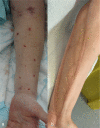Upper limb extravasation of cytotoxic drugs: results of the saline washout technique in children
- PMID: 32582391
- PMCID: PMC7302410
- DOI: 10.1302/1863-2548.14.200020
Upper limb extravasation of cytotoxic drugs: results of the saline washout technique in children
Abstract
Purpose: Extravasation of cytotoxic vesicant drugs is a surgical emergency (within six hours) since this incident can lead to severe skin and soft-tissue damage. Outcomes after the saline washout procedure have been extensively described in adults, but rarely in children. The aim of this study was to evaluate the outcome of early saline washout procedure for upper limb cytotoxic drug extravasation in children.
Methods: All consecutive children with vesicant drug extravasation were retrospectively reviewed. The saline washout procedure was performed. Cosmetic aspect, residual pain and range of movement were analyzed as well as time to surgery and chemotherapy resumption at last follow-up.
Results: Between 2014 and 2018, 13 cytotoxic vesicant drug extravasations occurred (mean age 8 years (sem 5)), including 11 treated by the saline washout procedure. At mean follow-up of 11 months (sem 7), the patients had no or low pain and ranges of movement were fully conserved. Two patients (one within the six hours' delay) had soft-tissue necrosis leading to extensive reconstructive surgery.
Conclusion: The saline washout procedure is safe and easy and significantly reduces the incidence of extensive skin damage. Early referral to a specialized department is essential. However, the key parameter remains prevention by educating medical staff and nurses about these injuries and by training them for early and urgent management.
Level of evidence: IV.
Keywords: chemotherapy; children; cytotoxic solutes; extravasation; saline washout procedure; upper limb; vesicant agent.
Copyright © 2020, The author(s).
Figures



Similar articles
-
The efficacy of saline washout technique in the management of exfoliant and vesicant chemotherapy extravasation: a historical case series report.Eur J Cancer Care (Engl). 2013 Mar;22(2):169-78. doi: 10.1111/ecc.12023. Epub 2013 Jan 16. Eur J Cancer Care (Engl). 2013. PMID: 23320981
-
Chemotherapy extravasation injuries beyond the immediate stage: A series of 15 cases treated according to a preset surgical algorithm based on time of presentation.Hand Surg Rehabil. 2022 Jun;41(3):391-399. doi: 10.1016/j.hansur.2022.02.009. Epub 2022 Mar 10. Hand Surg Rehabil. 2022. PMID: 35283338
-
Early surgical suction and washout for treatment of cytotoxic drug extravasations.Acta Chir Belg. 2000 Feb;100(1):37-8. Acta Chir Belg. 2000. PMID: 10776527
-
Extravasation management.Semin Oncol Nurs. 2007 Aug;23(3):184-90. doi: 10.1016/j.soncn.2007.05.003. Semin Oncol Nurs. 2007. PMID: 17693345 Review.
-
Extravasation emergencies: state-of-the-art management and progress in clinical research.Memo. 2016;9(4):226-230. doi: 10.1007/s12254-016-0304-2. Epub 2016 Dec 5. Memo. 2016. PMID: 28058065 Free PMC article. Review.
Cited by
-
Retropharyngeal Abscess in a Neonate After Extravasation Injury: To Drain or not to Drain?Turk Arch Otorhinolaryngol. 2021 Dec;59(4):292-296. doi: 10.4274/tao.2021.2021-4-13. Epub 2022 Feb 22. Turk Arch Otorhinolaryngol. 2021. PMID: 35262047 Free PMC article.
-
Extravasation Injuries of the Limbs in Neonates and Children—Development of a Treatment Algorithm.Dtsch Arztebl Int. 2021 Aug 23;118(33-34):547-554. doi: 10.3238/arztebl.m2021.0220. Dtsch Arztebl Int. 2021. PMID: 34158148 Free PMC article. Review.
-
The Role of Nursing in the Management of Chemotherapy Extravasation: A Systematic Review Regarding Public Health.Healthcare (Basel). 2024 Jul 22;12(14):1456. doi: 10.3390/healthcare12141456. Healthcare (Basel). 2024. PMID: 39057599 Free PMC article. Review.
References
-
- Khan MS, Holmes JD. Reducing the morbidity from extravasation injuries. Ann Plast Surg 2002;48:628-632. - PubMed
-
- Schrijvers DL. Extravasation: a dreaded complication of chemotherapy. Ann Oncol 2003;14(suppl 3):iii26-iii30. - PubMed
-
- Santoshi JA, Pallapati SCR, Thomas BP. Hand contracture: an unusual sequel of intravenous fluid extravasation in the neonatal period. J Postgrad Med 2008;54:244-245. - PubMed
-
- Vandeweyer E, Heymans O, Deraemaecker R. Extravasation injuries and emergency suction as treatment. Plast Reconstr Surg 2000;105:109-110. - PubMed
-
- Boyle DM, Engelking C. Vesicant extravasation: myths and realities. Oncol Nurs Forum 1995;22:57-67. - PubMed
Publication types
LinkOut - more resources
Full Text Sources
Research Materials

